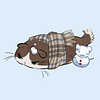Take a photo of a barcode or cover
I wanted to like this, but so little of the story focused on the actual pandemic. There was WAY too much about various doctors, and I got them mixed up after a while.
John M Barry manages to craft a rather interesting, albeit lengthy, book on the 1918-1919 flu pandemic by placing the focus on the human side of things. A multitude of factors contributed to the spread of the Spanish flu, including the very sad state of the medical profession at the turn of the century, the movement of troops during the war, blocking the flow of truthful information to the public in the name of boosting morale leading to mistrust and widespread fear, and the long-held misidentification of a bacteria as the cause of flu rather than a virus. What was most impressive to me was Barry's ability to clearly communicate the intricate structures of viruses to readers who likely lack a background in molecular biology.
If one is only interested in the scientific aspects of the Spanish flu pandemic, this is not the book for you. For me, I come away from this book with a richer understanding of the many factors (political, social, academic, etc) which ultimately determine the course a disease takes through a population.
If one is only interested in the scientific aspects of the Spanish flu pandemic, this is not the book for you. For me, I come away from this book with a richer understanding of the many factors (political, social, academic, etc) which ultimately determine the course a disease takes through a population.
informative
I have two important things to say up front: 1) this book is an amazing account of the 1918 Influenza Pandemic and 2) the editor of this book was asleep at the wheel.
Because of the incredibly poor/uneven editing, this book could be very difficult to get caught up in. There is a lot of information that Barry is trying to convey and the initial chapters don't do a very good job in getting it across in a compelling way. Just prior to the 1918 pandemic, there were huge leaps in medical science as well as drastic changes to just what a doctor does that are explained and explored. And while nearly all of it ends up being useful backstory to the pandemic, the execution is dry and leaves much to be desired. Ditto to the very important (but DRY as DUST) explanations of how viruses work.
But within even the dryness of this backstory are some interesting stories about big changes in medicine and the men and women that led them. There are also some juicy stories about how politics shaped some of the major institutions of medicine and medical research we know today.
But the most important and interesting part of this story, is the account of the Pandemic itself. From the way American military indecision assisted the spread of influenza among troops to how censorship possibly led to even greater infection rates, the story is compelling. It's difficult not to be swept along in the story and imagine the fear and panic of people living through the pandemic. Newspapers and community leaders aren't saying anything (an attempt to keep morale high during WWI and minimize panic) and meanwhile everyone around you is sick, dying or already dead? It's a terrifying and unsettling image, but it's painted very vividly using multiple accounts from across the country.
(as a digression from my overall review, I will say, of particular interest to me, was an account of how Native Alaskans were hit particularly hard by the outbreak and how white Alaskans refused to allow their tax dollars to be spent to assist in protecting and assisting Native Alaskans struck by the disease. White Alaskans, the book informs us, were protected, but believed their tax money "should be spent for the improvements of the Territory" and wanted the federal government to care for Native Alaskans. The governor of Alaska was given half the funds he asked for and a Navy ship from the federal government, but when he and the relief effort arrived, it was too late. Entire villages were wiped out and in those where there were survivors, many of them were children and many of them froze to death.
A few chapters later, Barry goes on to talk about the lack of significant racial tension or violence during the pandemic and described those in charge during the pandemic using their power for the general good.
This very clear depiction of colonial violence, resulting in large numbers of a native population dying, juxtaposed with a repudiation of any such violence only a short while later in the text, is both disgusting and illuminating. It also makes me wish for an account of the Pandemic from native populations as well as populations of color (both within the United States and internationally, as the international side of the 1918 Pandemic aren't explored in great detail)
If you're interested in disease pandemics, historical medicine or just scaring the hell out of yourself, I'd recommend this book.
Because of the incredibly poor/uneven editing, this book could be very difficult to get caught up in. There is a lot of information that Barry is trying to convey and the initial chapters don't do a very good job in getting it across in a compelling way. Just prior to the 1918 pandemic, there were huge leaps in medical science as well as drastic changes to just what a doctor does that are explained and explored. And while nearly all of it ends up being useful backstory to the pandemic, the execution is dry and leaves much to be desired. Ditto to the very important (but DRY as DUST) explanations of how viruses work.
But within even the dryness of this backstory are some interesting stories about big changes in medicine and the men and women that led them. There are also some juicy stories about how politics shaped some of the major institutions of medicine and medical research we know today.
But the most important and interesting part of this story, is the account of the Pandemic itself. From the way American military indecision assisted the spread of influenza among troops to how censorship possibly led to even greater infection rates, the story is compelling. It's difficult not to be swept along in the story and imagine the fear and panic of people living through the pandemic. Newspapers and community leaders aren't saying anything (an attempt to keep morale high during WWI and minimize panic) and meanwhile everyone around you is sick, dying or already dead? It's a terrifying and unsettling image, but it's painted very vividly using multiple accounts from across the country.
(as a digression from my overall review, I will say, of particular interest to me, was an account of how Native Alaskans were hit particularly hard by the outbreak and how white Alaskans refused to allow their tax dollars to be spent to assist in protecting and assisting Native Alaskans struck by the disease. White Alaskans, the book informs us, were protected, but believed their tax money "should be spent for the improvements of the Territory" and wanted the federal government to care for Native Alaskans. The governor of Alaska was given half the funds he asked for and a Navy ship from the federal government, but when he and the relief effort arrived, it was too late. Entire villages were wiped out and in those where there were survivors, many of them were children and many of them froze to death.
A few chapters later, Barry goes on to talk about the lack of significant racial tension or violence during the pandemic and described those in charge during the pandemic using their power for the general good.
This very clear depiction of colonial violence, resulting in large numbers of a native population dying, juxtaposed with a repudiation of any such violence only a short while later in the text, is both disgusting and illuminating. It also makes me wish for an account of the Pandemic from native populations as well as populations of color (both within the United States and internationally, as the international side of the 1918 Pandemic aren't explored in great detail)
If you're interested in disease pandemics, historical medicine or just scaring the hell out of yourself, I'd recommend this book.
dark
informative
slow-paced
informative
fast-paced
Funny how history repeats itself and we learn nothing.
This was a good read during the current pandemic. Good, but scary. And even better in combination with some of the other books written on the search for the virus.
Seriously, put on your science and history caps before embarking on this almost textbook account of the 1918 influenza in the US. This could be a great read for an epidemiology or virology course given the amount of scientific information the author presents. It is also a great account of the medical history of physician training and practice in the US as well as the history of Johns Hopkins. Also presented are personal stories and accounts of the early medical research performed under the name of "medicine."
Also contains easily understood science lessons on the spread of disease, in particular H1n1 and avian flu.
Also contains easily understood science lessons on the spread of disease, in particular H1n1 and avian flu.
I loved some parts of this book and really struggled with others. This is not an easy ready, it's heavy, it's depressing, but fascinating. My sped my way through how the disease spread (one mail boat essentially wiped an entire Alaskan village) and slogged through the knee deep science I didn't understand. My favorite portion was the development of medical education in the United States. I'm grateful they now have med schools that require at least a college education.





